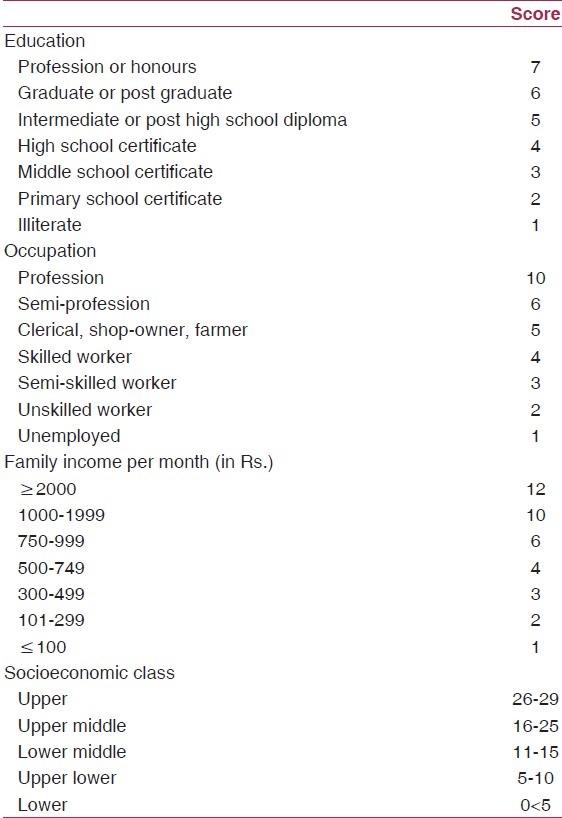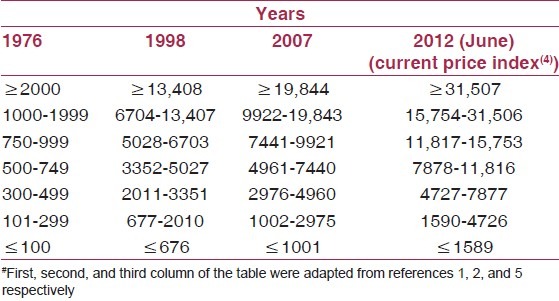Sir,
Socioeconomic status (SES) is one of the most important social determinants of health and disease, thus, widely studied constructs in the social sciences. Usually composite scales are used to measure SES, which has a combination of social and economic variables. Several ways of measuring SES have been suggested for categorizing different rural and urban populations in last decades.
The most widely used scale for urban populations is Kuppuswamy’s socioeconomic scale, which was devised by Kuppuswamy in 1976. Kuppuswamy scale is a composite score of education and occupation of the head of the family along with monthly income of the family, which yields a score of 3-29. This scale classifies the study populations into high, middle, and low SES [Table 1].(1) Usually education and occupation of head of family are not changeable with time. However, the income ranges in the scale lose their relevance following the depreciation in the value of the rupee.(2) Steady inflation, lower interest rates, and country’s current account deficits are the main factors contributing to fall in the value of currency. Therefore, it is needed to update the scale regularly for socioeconomic classification of study populations. In the past, Kumar(3) had tried to update Prasad Scale’s income limits using consumer price index (CPI) as a first attempt of its kind. In this letter, we attempted to link income limits of the Kuppuswamy socioeconomic scale with CPI and revised the scale. Such linking of the scale with price index not only makes it relevant and meaningful but also provides a built in opportunity for its constant updating in future.
Table 1.
Kuppuswamy socioeconomic scale (Urban, 1976)(1)

The family income per month (in rupees) for 1976 was calculated according to base year 1960 = 100 (using the price index for 1976: 296). These price indexes entail that anything that costs Rs. 100 in 1960 would cost Rs. 296 in 1976. The price indexes were updated for 1982 and again in 2001 assuming them as base year (100).(4) The scale has been revised previously by Mishra et al., for 1998 price index,(2) Kumar et al.,(5) and Patro et al.(6) Keeping the changing socioeconomic circumstances in mind, income criteria in this paper again revised using the base year of 2001 for All India CPI numbers for industrial workers on base 2001 = 100 (CPI-IW).(3) Price index for 2001 according to 1982 base (100) was 458. As per criteria of 1960 (old base), the price index for 1982 was updated at 490. Therefore, we get price index of 1976 converted to new base:
Price index for 1982 by 1960 base = 490
Price index for 1982 by 1982 base = 100
Price index for 1976 by 1960 base = 296
Price index for 1976 by 1982 base = 296 χ 490/100 = 60.408.
This means the item which costs Rs. 100 in 1982 was Rs. 60.4 in 1976. Conversion factor for the year 1982 would be 4.90 (296 χ 60.408). Conversion factor takes into account the increase in base price index for which it is calculated. Considering the new base (2001), price index for current year (2012) is used to establish new ranges of income. Updated conversion factor can be established using same exercise as follows:
Price index by old base (1982) for 1998 = 405
Price index for 2001 by new base (2001) = 100
Price index by new base (2001) for 1998 = 405 χ 458/100 = 88.428
Price index by new base (2001) for 2012 = 208.
Conversion factor for the year 2012 can be achieved by dividing the price index (2012) by 88.428. CPI-IW (base 2001 = 100) shows reference index numbers as 208 on June 2012 as per Labour Bureau, Government of India.(4) Price index was 88.42 for 1998 and 208 for 2012 so conversion factor with 2001 as new base will be 2.35 (208 χ 88.42) [Table 2].(1,2,4,5)
Table 2.
Family income (Rs.) per month in the original and modified Kuppuswamy scale#

This revised method for SES has limitations. Educational and occupational factors need to be revised by using suitable survey methods.(2) The total family income is being used in this scale, itself is a limiting factor as it does not take into account the family size. In today’s time with shrinking family size, best expressed with double income no kid syndrome; a small family with same income will enjoy an upward social mobility. However, this exercise will provide good understanding for deciding the income group in the scale considering the latest available CPI values.
The researchers need to take note of regular update of the CPI values available from Labor Bureau website before exercising socioeconomic classification of their study population in research.
Acknowledgments
The authors are thankful to Sumit Chawla and Manju Pilania, Pt. B D Sharma PGIMS, Rohtak for understanding of the calculations of price indexes.
References
- 1.Kuppuswamy B. Manual of Socioeconomic Status (Urban) 1st ed. Delhi: Manasayan; 1981. pp. 66–72. [Google Scholar]
- 2.Mishra D, Singh HP. Kuppuswamy’s socioeconomic status scale - A revision. Indian J Pediatr. 2003;70:273–4. doi: 10.1007/BF02725598. [DOI] [PubMed] [Google Scholar]
- 3.Kumar P. Social classification - Need for constant updating. Indian J Community Med. 1993;18:60–1. [Google Scholar]
- 4.Labour Bureau; Ministry of Labour; Government of India. Linking factors between new series and old Series. [Last accessed on 2012 Aug 7]. Available from: http://labourbureau.nic.in/indexes.htm .
- 5.Kumar N, Shekhar C, Kumar P, Kundu AS. Kuppuswamy’s socioeconomic status scale - Updating for 2007. Indian J Pediatr. 2007;74:1131–2. [PubMed] [Google Scholar]
- 6.Patro BK, Jeyashree K, Gupta PK. Kuppuswamy’s socioeconomic status scale 2010 the need for periodic revision. Indian J Pediatr. 2012;79:395–6. doi: 10.1007/s12098-011-0517-7. [DOI] [PubMed] [Google Scholar]


